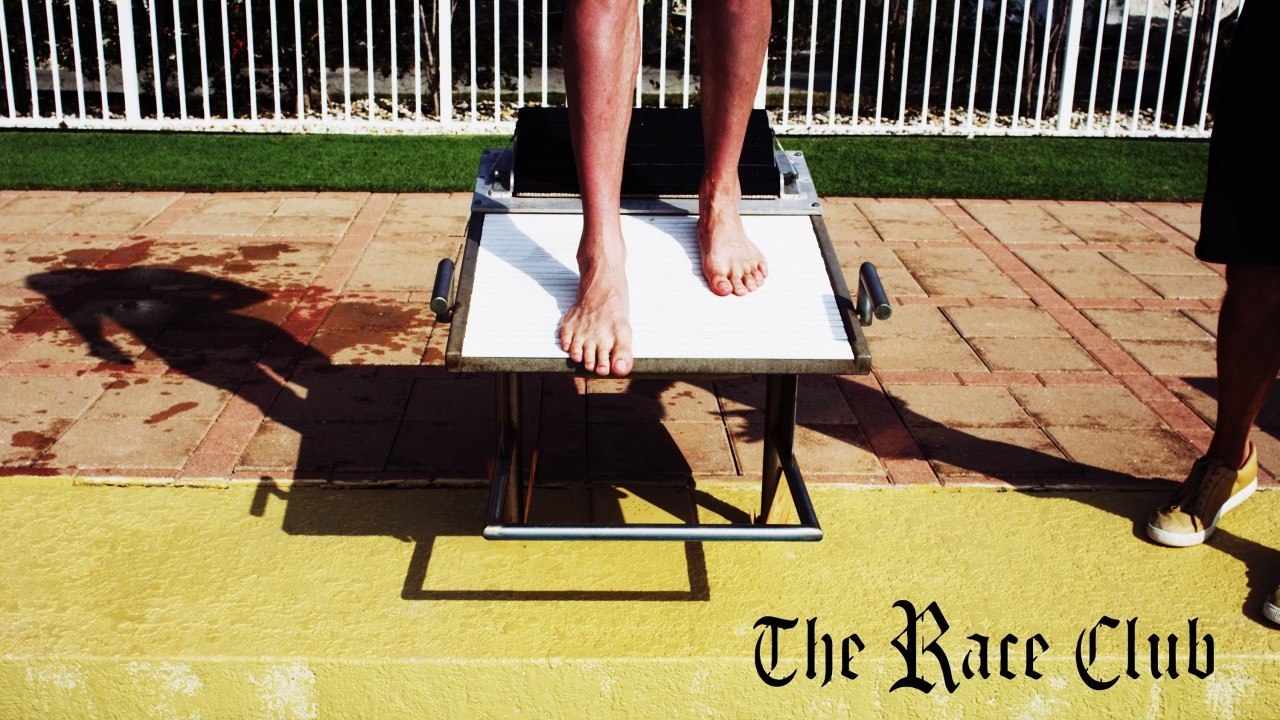Courtesy of Gary Hall Sr., 10-time World Record Holder, 3-time Olympian, 1976 Olympic Games US Flagbearer and The Race Club co-founder.
Part I: After the whistle blows
Getting off to a good start is one of the most important parts of the swimming race. The shorter the race, the more important the start becomes. Last spring at The Race Club, we had the opportunity to learn from one of the best starters in history, Roland Schoeman. Roland also offers private or group instruction for those wanting to learn more. He is available in Phoenix, Arizona.
Get Positioned Properly
Once the whistle blows, signaling that the athletes can mount the starting block, it is important to get positioned properly. With the new adjustable back footplates, one needs to know where to position the plate (forward or backward) for the optimum attainable force. This will change depending on the swimmer’s height and whether he/she chooses to be weight forward or backward after the command. It is extremely important to practice some starts in warm up with the starting block in the racing pool to be absolutely certain where to place the footplate. Different companies manufacture these blocks, so one cannot assume that they are all the same.
Front Foot Is Positioned First
Once you have climbed on top of the starting block, the front foot is positioned first with the longest toes hanging slightly over the front edge of the block. If you are not certain which foot should go forward, practice it both ways and see which way feels more comfortable. If you are still not sure, imagine doing a lay up in basketball. Which foot would you jump off of? That should be the foot that is forward.
Back Foot – Heel Slightly Off The Plate
After setting the front foot, position the back foot on the plate where you want it with the heel slightly off the plate, resting on the ball of that foot. The feet should be placed about shoulder width apart and both feet should be pointing forward.
Once Feet Are Planted You Do NOT Want To Stand Up
When both feet are planted you do not want to stand up, nor do you want to place your hands on your knees, bent slightly at the waste. From either position, when the command to take your mark occurs, it will take too long for you to bend over, grab the front of the block (or the bars on top of the block) and lean backward into the cocked position. Starting from this elevated position, too many swimmers have heard the beep go off while pulling themselves backward, leaving them far behind. Instead, you should hang down from the waste, arms relaxed and loosely grab the front of the block or bars with fingers of both hands. Do not pull up tightly with your arms until after the take your mark command is given.
Head in Neutral Postion Or Slightly Extended
The head should be positioned in a neutral position or slightly extended. That means you will be looking down toward your front heel or toward the middle of the surface of the starting block. You do not want to extend the neck too far forward, as that will tend to make you feel tight and uncomfortable. At this point, you do not need to look forward and see the water in front of you. You know the water is out there.
“No Part” Of Your Body Should Feel Extremely Tense
With the head in this neutral position, the fingers loosely holding on to the block or the bar, your weight should be placed mostly on the front foot, with the longest toes of that foot wrapped around the edge of the block. No part of your body should feel extremely tense. You are now ready for the command of the starter.
For video images of good starts, please watch this Swimisode:
Yours in swimming,
Gary Hall Sr.
Like The Race Club on Facebook
Follow The Race Club on Instagram
Follow The Race Club on Twitter
Connect to The Race Club / Gary Hall Sr. on Linkedin
[email protected]
See The Race Club HQ here.
THE RACE CLUB
Because Life is Worth Swimming, our mission is to promote swimming through sport, lifelong enjoyment, and good health benefits. Our objective is for each member of and each participant in The Race Club to improve his or her swimming performances, health, and self-esteem through our educational programs, services and creativity. We strive to help each member of The Race Club overcome challenges and reach his or her individual life goals.
 The Race Club provides facilities, coaching, training, technical instruction, video, fitness and health programs for swimmers of all ages and abilities. Race Club swim camps are designed and tailored to satisfy each swimmer’s needs, whether one is trying to reach the Olympic Games or simply improve one’s fitness. Our programs are suitable for beginner swimmers, pleasure swimmers, fitness swimmers, USA swimming or YMCA swimmers, or triathletes; anyone who wants to improve swimming skills. All of our Race Club members share an enjoyment of being in the water and use swimming to stimulate a more active mind and body.
The Race Club provides facilities, coaching, training, technical instruction, video, fitness and health programs for swimmers of all ages and abilities. Race Club swim camps are designed and tailored to satisfy each swimmer’s needs, whether one is trying to reach the Olympic Games or simply improve one’s fitness. Our programs are suitable for beginner swimmers, pleasure swimmers, fitness swimmers, USA swimming or YMCA swimmers, or triathletes; anyone who wants to improve swimming skills. All of our Race Club members share an enjoyment of being in the water and use swimming to stimulate a more active mind and body.


Is be very interested to hear your opinion in when top sprinters take their last breathe before the start of the race. Obviously to be competitive now at the global level you have to be Able to swim a 50 without breathing, but do top sprinters breathe as the starter says take your marks or do they breathe in mid air?
Great Question. After the beep, the swimmer bears down with core strength (valsalva) while pushing off the block, which makes it impossible to take a breath. Therefore, the last breath taken should be taken when the starter commands to take your mark.
Why wouldn’t the swimmer forcefully exhale as they exert force and inhale mid air? Valsalva is used by Olympic/Power lifters whose lifts can take seconds. Wouldn’t a start more closely resemble a punch in boxing or a swing in tennis, both of which result in audible exhalation?
Another great question…and one I did not have an immediate answer to, so I did a little research. There is approximately .8 seconds time between the beep and when the hands hit the water (with normal reaction time). Some swimmers will hold their breath during that period after the initial force of the legs and arms off of the block. Others exhale after the force, followed by an inhale before the entry. Either way seems to work, depending on the preference of the swimmer. The important part is to have air in the lungs at entry, so the body will get back to surface easier.